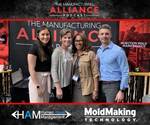Planning for Manufacturing Change and Technology Readiness
Consider how the manufacturing process will change in the next ten years and then start planning to be technology- and workforce-ready.
A few years ago, I introduced the industry to my son Gabriel, who has Williams Syndrome (a disorder caused by the deletion of genetic material from a specific region of chromosome 7, which includes 26 to 28 genes that impact both physical and cognitive abilities). I decided to share my story (which, by the way, compelled people to reach out to me about their children — a testament to this wonderful industry) because at the time, my husband and I were attending every conference, lecture, seminar and trade fair that we could find to get up to speed, and more importantly to get ahead of what was to come with Gabriel’s development. It was then that I used my personal experience to craft a message encouraging mold builders to get out of their shops to learn something new and connect with people who have the same challenges. At the time, I was specifically motivated to help you get up to speed and get ahead of the challenges coming your way in the world of mold manufacturing by attending Amerimold.
Well, my life with my son provides another appropriate example. This time, it’s about readiness. Readiness for my husband and I is focused on preparing for the multitude of challenges and opportunities Gabriel will face once he transitions from school to the work world. The readiness I am talking about for you is different but no less important.
Last year we presented workforce readiness with the expert help of newEditorial Advisory Board member and talent consultant Marion Wells of Human Asset Management through an industry workforce readiness survey and panel discussion at Amerimold 2019. This month, I present to you technology readiness because it goes hand in hand with workforce readiness to create the mold manufacturing ecosystem. And just like any ecosystem, yours is also threatened by predators … your competition and the changing landscape of mold manufacturing.
To keep your ecosystem thriving, every mold builder must strike a balance between workforce and technology readiness as 2030 approaches — the impending deadline for the shift in both the people and process sides of mold manufacturing.
In a nutshell, technology is defining the work you do — whether that involves Industry 4.0, additive manufacturing, robotics, artificial intelligence, augmented reality or any advanced manufacturing technology — so evaluating and adjusting your workstreams in alignment with each new technology implementation is critical. This requires better planning.
Last year, we focused you on the people, and this year we are going to focus on the tools to give your people — namely, technology to be more effective and to protect your investment. It’s time to start seriously thinking about how your manufacturing process will change in the next 10 years, so you can start planning to be technology- and workforce-ready. We will be developing our 2020 content in that spirit of readiness — focusing on what works and what’s new with both workforce and technology.
Related Content
-
What Is the 2023 “Customs & Practices of the Moldmaking Industry Guide”?
Are you aware of the updated “Customs & Practices of the Moldmaking Industry Guide”?
-
More Than Moldmaking at PTXPO 2023
The Moldmaking Pavilion returns to the Plastics Technology Expo (PTXPO) March 28-30, 2023, at the Donald E. Stephens Convention Center in Rosemont, Illinois, but there’s more to discover than moldmaking.
-
Tackling a Mold Designer Shortage
Survey findings reveal a shortage of skilled mold designers and engineers in the moldmaking community, calling for intervention through educational programs and exploration of training alternatives while seeking input from those who have addressed the issue successfully.












.jpg;maxWidth=300;quality=90)



